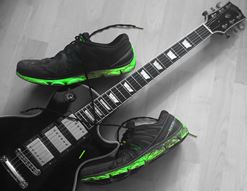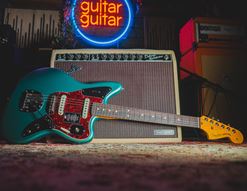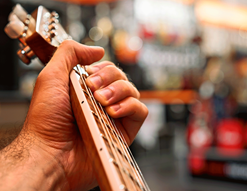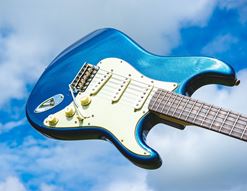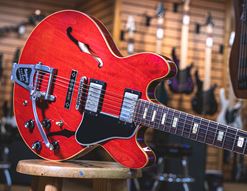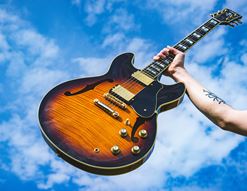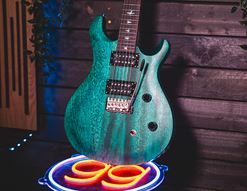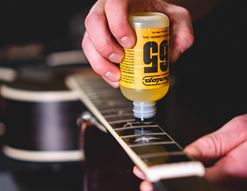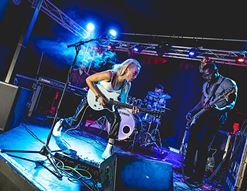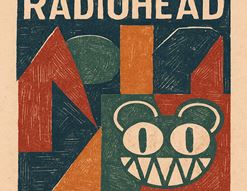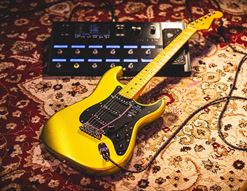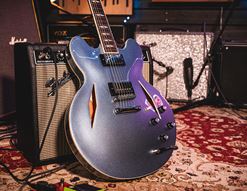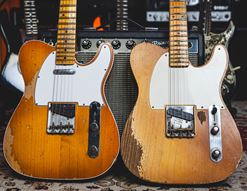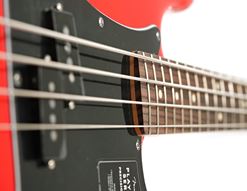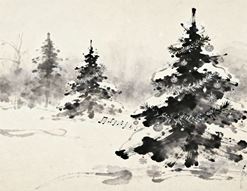Did you catch the legendary Acka-Dacka when they made their single UK tour stop in Edinburgh? If you did, I hope you had a blast. If not, don’t worry: fire through this guide today instead and feel the full power of molten rock!

Yes, I want to help you sound and play like Angus and Malcolm today, with some straightforward advice, insights and tips from my years of experience as a guitarist, producer and writer. AC/DC’s music is deceptively simple, but that doesn’t mean there aren’t things you can learn on the way. If the time has come to rock, then do it right with this guide to sounding like AC/DC…
Contents
How to Sound & Like AC/DC: Some Tips
How to Sound Like AC/DC
Today’s guide will be divided into two main sections. Firstly, I’ll check out the gear used by the brothers Young, and how you can translate that into everyday gear you can buy and use right now.
Secondly, I’ll look at the band’s unique sound and style, and offer up some ways in which you can adopt a little of that thunderstruck magic to your own playing.
Sound good? Excellent. And no, you don’t have to wear that school uniform unless you really want to, ok?
AC/DC Gear: Guitars
Gibson SG
I expect most of you will already know that Angus is a loyal Gibson SG player. It’s his trademark guitar, to the point where almost any cherry SG Standard can be seen as an ‘AC/DC guitar’.
That’s when you know you are popular.

To that end, I’d say that all Epiphone and Gibson SG models with humbucker pickups will be suitable for this style. You don’t need specific details or vintage years, none of that. A good, solid SG with two humbuckers (neither too hot nor too vintage) is the correct tool for Angus tone!

Go with what suits your budget. Epiphone make excellent SG Standard models that will absolutely nail the Angus tone. Gibson of course are the ‘full-fat’ choice, and you can have a Gibson 1961 SG if you really want a guitar that’s Angus-like. It has a skinnier neck than the Standard model, so why not A-B the two and go with what feels best?
Gretsch Jet
For Malcolm’s signature rhythm sound, you can look towards Gretsch. Although you’d see him playing a Falcon now and then, he was best known for his red Pro Jet doublecut model which subsequently became more and more dinged up over the years. Pickups were removed along with the finish, controls were thrown out and the whole object got increasingly simplified until his guitar resembled a beaten up old boat. Indeed, the guitar you are thinking of was never a ‘natural’ finish when it left the factory!

There have been reissues of Malcolm’s Gretsch, but I reckon you’ll get what you need with any of today’s Jet models, either from the Gretsch Professional range (though most of these Jets seem to be singlecuts, not that it’ll affect the sound!) or the cheaper Electromatic range. I reckon you’ll get very agreeable results from the Gretsch G5222, in Natural of course, unless you want to ‘do a Malcolm’ and strip the finish from a red one yourself. No refunds!

AC/DC Amplifiers
Let’s call a spade a spade. The AC/DC sound is Marshalls. Marshall cranked in volume but not necessarily in terms of gain. Volume plays a huge part in the sound of this band - they do it the old way - so keep that in mind.
Which Marshall though? Well, the ones they used most were the 1959 Super Lead heads with the four inputs. In other words, a ‘Plexi’. Angus also used a relatively rare JTM50, which was a model that sat in between the JTM45 and the Plexi.

Fine, but to me, this all says one thing: go for a Plexi or equivalent, and don’t go daft with the gain. Marshall still do a great Plexi in the form of the Marshall 1959HW, a boutique-level hand wired head. This is absolute bullseye stuff for the sounds we want, so go directly for this if you have the cash.

However, it’s hardly a quest for the Holy Grail these days if you want to find yourself good Plexi tones. They are everywhere! Other top-end brands like Friedman and Suhr offer their takes, but literally every digital modeller under the sun will have a decent Marshall Plexi preset on it. Some will be better than others, but this sound is so in demand with guitarists of all styles, that nobody nowadays goes too far wrong in their approximations.

Try the Line 6 Helix family for exhaustive solutions to your needs, and also the Neural Quad Cortex, the Strymon Iridium and, if you want to keep it super simple, the Universal Audio UAFX Lion pedal.
AC/DC Pedals
AC/DC pedals? Haha, come on now. Plug your guitar directly into your amp and stop your nonsense.
Strings and Picks
Malcolm Young used super heavy strings: 12-56. I don’t think you have to do the same, but it’s your tendons! In addition, he used (as far as my research has gathered) Fender Extra Heavy picks. These are roughly 1.20mm (could be as heavy as 1.5mm, they get quite inconsistent) and would most likely be celluloid. Today, D’Addario do nice Satch Grip Picks which are 1.5mm celluloid and have a textured surface to stop you dropping them. This will come in handy when you are mid-riff frenzy and covered in rock sweat, so I recommend them if you prefer not looking like a loser.
Angus, on the other hand, uses Ernie Ball 9-42 strings since he has to play more lead parts. These are surprisingly light, but then he is also a fairly tiny guy, so I recommend trying a set of 10-46 as well, since it’s more about what feels good to you.
For picks, he obviously just stole them off his big brother since he uses the same Fender Extra Heavy ones in the generic 351 shape. Go for them or take my advice on those D’Addario ones.
How to Sound & Like AC/DC: Some Tips
Okay, the gear was pretty straightforward, and to be honest, so is the playing. Here are some general dos and don'ts to keep in mind when investigating this style…
Go easy on the distortion: dial that gain back to around midday and adjust from there. If you listen closely to the records, neither Young brother is going nuts with distortion at all. There is the illusion of gain because they are both rocking hard, but you need tightness in your sound more than anything else, so calm down on the overdrive levels and watch your tone transform.
Turn it up: yes, volume affects tone. Of course it does! If you’ve spent all your days playing through plugins and digital amps, this concept might actually throw you a little, and I’m not trying to sound condescending. All characteristics of attack, response, EQ and overtone change dramatically when an amp is cranked beyond bedroom levels. Ever wonder why so many amp guys set everything to noon and then just blast the volume? Try it yourself and find out why.
No ambience, no effects: turn off your delay. Turn off your compressor. Think twice about the reverb as well. If you can hear reverb on the AC/DC records (and I’ll concede that I almost can now and again), then understand that it’s the mics picking up the natural reverb of the room. It’s not a reverb effect being applied. So, do the same! Ditch the ambience and simply turn yourself right up. I keep saying it, but you need to do it!
Meat and Potatoes: keep your chords and scales simple. Open chords, power chords and the odd barre chords are all you need for those rock-solid foundations. For leads, don’t stray too far from the Minor Pentatonic unless you want to appear ‘fancy’. That is entirely not the point here! Angus throws in plenty of ‘blue’ notes, so obviously the Blues scale is the one to use, but you already knew that. Keep the Phrygian Dominant for another gig, okay?
Don’t Weave: Keith Richards talks about the ‘ancient art of weaving’, which really just means him and Ronnie Wood sharing lead and rhythm duties. They salt and pepper each others’ playing very tastefully, but that’s not what is wanted today! If you are copping an AC/DC vibe, then one guitarist will only EVER play rhythm, okay?
Leave gaps: think of your favourite Acka-Dacka riffs. Now consider how many of them have spaces left for the notes to breathe. That’s right: practically ALL of them. That’s rock music, folks: the spaces in between the crunch. If you overplay, you just tire everyone out and sound like a rank amateur. If you want to own that stadium one day, then understand that the space in between notes is where your audience gets to join in and be a part of the whole experience. Play less, and play with intent.
Rock and Roll Ain't Noise Pollution
I’ve spent all of this article telling you to keep it simple and to turn it up. Really, there’s nothing much else to it but that. Riffs are primal things that you feel and react to, so volume is important. If you have neighbours who do not appreciate the righteous power of rock, then get yourself into a rehearsal room and go crazy. It’s worth it on so many levels. Don’t forget to bring ear plugs, and don’t listen to anybody who says you don’t need them. The volume you need is for your sound, nothing else.
And for those about to rock…everyone at guitarguitar salutes you.


